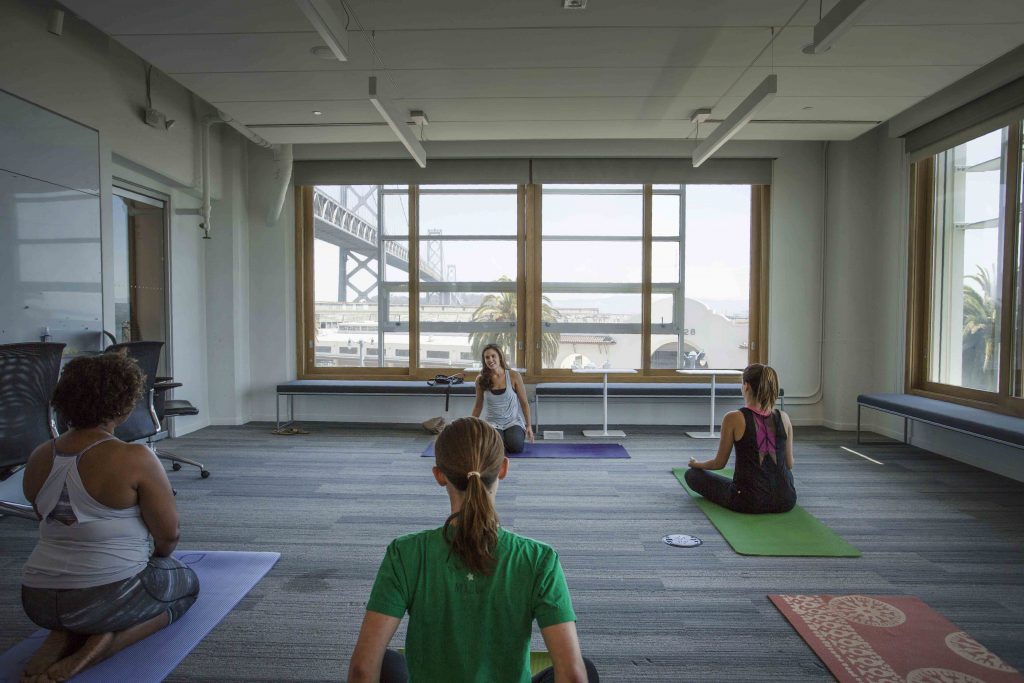Two years ago, Alley Ramon began teaching a free weekly yoga class for employees here in Perkins+Will’s San Francisco office.
I started working here a few months after the classes started, but—I’m ashamed to admit this—I went almost a year without taking a single one. Each morning, I’d sit down, put on my work-blinders, and fall into a pattern somewhere between a groove and a rut. (Plus somehow I always conveniently forgot to bring shorts or a mat.)
I’m happy to report that I’ve broken free of my chair-based mentality—weekly yoga has been a highlight of the past six months for me.
The hour-long sessions are held at noon on Thursdays, in a conference room with a grand view of the Bay Bridge and San Francisco Bay. Class attendance is usually around five or six people. After changing into comfortable clothes in our locker room, we simply roll away chairs and tables and voila—our very own yoga studio. I return to my desk feeling, well, like I just stepped out of a yoga class, and my productivity only benefits from the break. When I see fellow yogis in the hallway later, we nod and smile in recognition of that post-class glow.
As a former dancer turned office-type, I wanted to learn what it’s like to teach yoga in a corporate setting. Speaking by phone last month, she told me that she’s been teaching yoga for ten years and came to the Bay Area in 2011 to pursue a master’s in clinical psychology. Her transition to corporate wellness coincided with the realization that teaching yoga in non-traditional settings could have a big impact on how people feel at work. Just as therapy doesn’t need a couch to deliver benefits, Ramon says, building a strong yoga practice doesn’t require a formal studio setting.
What are the factors that make an office-wide yoga class successful?
You don’t need expensive equipment or finely tuned logistics to have a successful class. The key is to have someone on the staff, not just from the HR department, who regularly attends class and becomes an internal advocate. The activity itself doesn’t really even matter. Yoga is great but it could just as well be boot camp, group walks—anything that breaks the corporate stereotype of sitting in front of a computer all day. Corporate life used to deny the existence of a body, of wellness. No longer! We are changing how we think about our lives when inside an office.
Is running classes in a conference room any different than running classes in a yoga studio?
There’s definitely a difference. In a studio setting, people seek out a certain practice and they come for that specific reason. They’ve likely had prior experience, and many don’t know each other. It can be very insular. In a corporate setting, it’s so much more inclusive, and people aren’t nearly as intimidated. So it’s easier for someone to just give yoga a try.
What changes do you tend to see in students once a yoga program is established?
People will come up to me to say things like “I’ve just really noticed a difference in my body,” “I can focus more at work,” or “I just feel better.” It’s surprising, but when students get better at yoga, they also start to report that they feel more supported by the company. They’re more excited about coming into the office, and the knowledge of that break in the week is very special. And even if you’re just walking by and not actually in the class, the mere presence of yoga here makes people automatically smile and get curious. It brings a breath of fresh air into the office environment.
Your yoga classes for us are one part of your practice—elsewhere, in addition to yoga, you teach mindfulness meditation, emotional regulation, and stress management. Why are corporate-wellness programs so popular?
In corporate wellness, students are introduced to a practice that is non-intimidating and totally inclusive. I’ve been with some of my other companies for five years, and I have seen firsthand how everyone, from upper management to junior level employees, ends up really valuing the programs. Long-term gains come from long-term investment in employee satisfaction. That satisfaction goes beyond their tenure at a company. And when people tell others that their old firm is a great place to work, that reputation spreads among candidates, and the cycle builds on itself.
Every firm today is competing with the tech industry to attract talent, especially here in the Bay Area. Achieving parity with Google and others means providing plenty of amenities and programs. Companies used to have the upper hand in the hiring process, but now it’s employees. Why would you take a job where they don’t value your wellness? You’re more likely to go with the place that has great benefits on top of the salary.
It would be interesting to quantify the value of a healthy employee versus the cost of an unwell one.
Yes, search “workplace wellness case studies” and take a look. Employees who prioritize health and wellness are less likely to call in sick, less likely to get upset. It decreases the bottom line without question, whether or not it can be substantiated in a straightforward way. But even without concrete data, it just makes sense: healthier means happier.
Having wellness classes onsite also helps employees make better nutritional choices. After a meditation class you’re less likely to binge on sweets. At a tech firm where I work, they now have less coffee and more fruit, eggs, and hummus, which help energize employees throughout the day. Today, it’s easy to feel overworked and stressed. Programs like the yoga classes at your office are a message from companies to their employees that work-life balance is imperative. That efficiency and mindfulness go hand in hand.
Since starting your class, I’m not so paralyzed by the need to get work done. I don’t get computer headaches anymore, and I’ve edited this piece at a standing desk. I wish I’d started taking your class a year sooner!
French, yes! This is why I do what I do. I have a passion for true, real, sustainable well-being. The more people can recognize and address the importance of incorporating wellness at work, the happier, healthier, and more productive we’ll all be.
From: ideas+buildings






